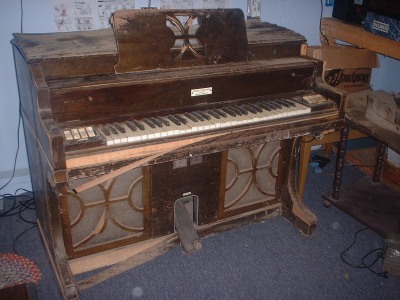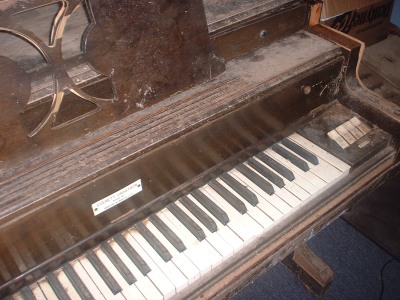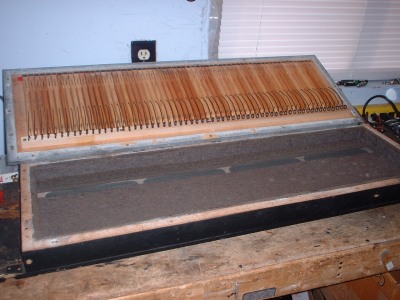







The Orgatron was introduced by the Everett Piano Co. of South Haven, MI, in the late 1930's. Up until that point, the only electric organs were really just hybrid versions of the traditional pump organ, using a large blower motor instead of foot-pumped bellows. The Orgatron took that idea one step further. The Orgatron's reeds were electrified, and the electrical signals they produced (when vibrating) were then refined and amplified by a large chassis with numberous vacuum tubes. The result was a sound much smoother and more powerful than the old pump organs, with a few added extras like acoustic tremolo. It was a historic era in the world of organs, however it was quite short-lived. The organs were very expensive to produce, extremely heavy and therefore difficult to transport, and their price tag was quite unappealing to the consumer - a typical Orgatron cost about the same as a full size church pipe organ! Not surprisingly, not very many of these were produced. I'm not sure of the exact production numbers, but based on serial numbers I've seen, I would estimate that fewer than 50,000 Orgatrons were sold in the US. And, to my knowledge, only about 100 were ever sold in Canada under the Mason & Risch name - which is why I considered mine such a rare find.
The Everett Piano Company eventually sold out to the Wurlitzer Co., who continued to use the "technology" for their own organs up until the mid-50's. By now, the Hammond organ had been in production for about 15 years and was quickly becoming the popular choice for churches and homes alike. Once the Hammond Organ Co. finally purchased Wurlitzer, the Orgatron was officially laid to rest.
Considering the rarity and historic significance of these organs, you'd think any surviving ones would be worth a fortune. Not exactly. Though I've only seen one or two of these ever come up for auction or sale, I think it's safe to say these are not the valuable finds you'd expect. There are two reasons; first of all, the Orgatron is relatively unknown. (Hammond, by comparison, is known and loved throughout the entire world). The other factor is condition. Most surviving Orgatrons are in fair condition at best, and as you will soon see, restoring one is a difficult task indeed. If one could be located in both good working and cosmetic condition, it may just have some value. It's really hard to say.
Anyway, back to the story of my restoration job.


Repairing the keys was a long and tedious job in itself. After the keys were removed, I first had to clean the many rusted keyshafts that prevented the keys from moving freely. Next, the worn or missing felt washers and paper spacers had to be replaced, to allow the keys to seat evenly. Tons of dirt particles (mostly from rodent nests) had to be vacuumed. And finally the keys had to be cleaned and polished to look and feel like new again.

Once the chassis was operational, I put it back in the organ and powered everything up. Although able to hear sound from the reeds, there was barely any sound coming from the speaker. Turns out there was more electronic work to do, not in the chassis, but in various modules located throughout the organ cabinet.
With no schematics of the smaller modules to go by, everything had to be done very carefully, and I had to create many crude sketches so I could backtrack if something went wrong. Most of the smaller modules consisted of several resistors and foil capacitors, all encased in wax. To remove the wax, I first chilled the units in a freezer and then chipped them apart with a chisel (cold wax becomes very brittle and easy to break). I replaced the components and re-sealed them with new wax.
I put everything back together again and finally managed to get a half decent sound. But some of the keys were louder than others; I soon discovered this was caused by dirty electrical connections, at the base of each reed. So, you guessed it, every last reed had to be removed so I could clean the connectors underneath. But once finished, the sound was even and consistent across the board, and the organ was basically ready to play.
Of course I wasn't quite finished - there was still the matter of restoring the cabinet. I had been slowly working on the various pieces while I was restoring the electronics, but now I was able to work on the cabinet full time. It was quite straightforward but very labourous - I had to reglue countless pieces of veneer, replace some missing pieces, fill in the details and prep for finishing, apply the stain and touch-up markings, and finally apply the finish. I used several brush-on coats of a semi-gloss Varathane, and even used a very light shading of black spray paint on a couple of pieces, to replicate the original dark finish.
And with that, my Everett Orgatron was finally restored. What had been ready for the landfill just two months earlier, was now ready to be played and displayed in someones living room. I've probably missed a few details of the restoration, but this certainly describes the most of it.
So was it worth it? Sort of. It was rewarding to see this piece restored, and be able to see and hear it in operation after decades of storage, but considering its low value I probably put a bit too much effort into it.
If you'd like to hear a sample of this rare organs sound, click here for a short recording (1.4Mb) of yours truly playing a popular Christmas song.
Comments: the background noise you hear is the huge blower motor that drives the reeds. The clicking sound near the end of the recording is our large dog walking by.
Or, click here to go back to the Before & After page..